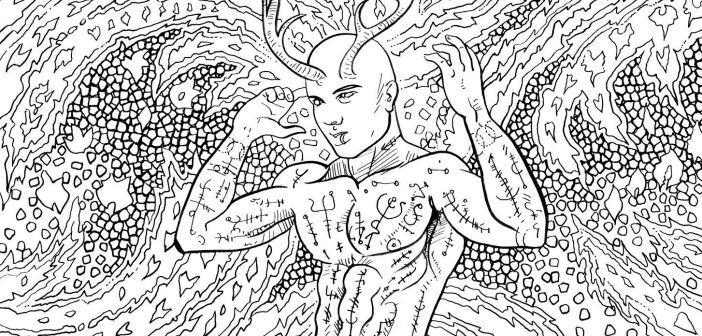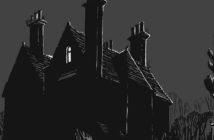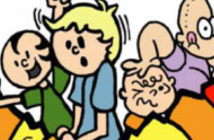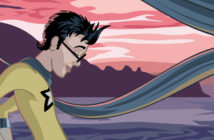Creator Jon Macy doesn’t shy away from pornography in comics. On his website, he states the following: “I believe that gay graphic novels need sex to be relevant. While my work is unashamedly erotic, I also try to present gay identities with real feelings and complex experiences. In my world, lasting relationships go hand-in-hand with passionate sex, and gay love tolerates no punishment.”
This is certainly true with Macy’s Teleny and Camille, the beautiful graphic adaptation of the first English-language novel depicting gay erotica often attributed to the whimsical Oscar Wilde, though it’s never been proven he’s truly the author. Romance stories tend to depict either love or sex, but rarely link the two as a union of emotions and feelings. Not so with Macy’s work, especially when considering the characters of Teleny and Camille: they’re flawed men trying to fill the voids in their lives, though success doesn’t favor them.
But that’s a story Macy didn’t entirely control—he reinterpreted the novel, Teleny, or, The Reverse of the Medal, but the tale itself wasn’t his original musing. But that’s been remedied by Fearful Hunter, an original, four-part miniseries completely born of Macy’s own ingenuity. The issues in the series are oversized, delivering a battering ram of lush narrative I don’t typically attribute to an independent miniseries.
Fearful Hunter tells the story of Oisin, a young mystic being trained in the magical arts of nature. His goal: to become a druid, and under the tutelage of his mentor, Tavius, his destiny is assured. Though, these druids are not the weathered and stooped Merlins associated with ancient Celtic lore, nor are they the contemporary casters gaming fiends will happily identify with World of Warcraft, Dungeons & Dragons, or Diablo. Macy’s naturalistic shamans flex muscled and tattooed bodies, shave their heads, and don’t shy away from piercings. It’s a wise decision—these simple alterations in archetypal character design allow the creator to build a world all his own, while blending traditional elements from both world myth and modern fantasy games.
It’s the charge of Oisin to complete his physical and spiritual training in order to bond with an Ally, a godly spirit of the earth that will grant the young druid strength and protection in exchange for a carnal price. These scenes of divine submission are intense—they’re acutely bizarre, somewhat unsettling, and wholly tantalizing. Bonding with an Ally is paramount, and Tavius does everything in his power to keep Oisin’s mind focused, despite his attraction to a young werewolf, Byron, whom he visits within his magical meditations. The love story begins here, as Oisin disobeys his master and sets out to both find his destined mate while also becoming a true druid.
Fearful Hunter exists in its own speculative world; time and space are removed from our own. Elements of ancient Britannia spill over into contemporary history—how else could I explain Oisin traveling outside the stone tower of his master and into a small town nearby, all the while wearing jeans and riding a bike. This was a great risk on Macy’s part: he could have very easily destroyed the tone and mood of his story, ultimately confusing the message. But he does not. It all works, and very well because these elements don’t draw attention to themselves. This world simply is, existing on its own terms. It’s what I call the “window approach” in genre fiction: a storyteller opens a window into their imagined world and we simply watch as events unfold. There’s no dry exposition or boring explanations.
It’s important to note that Fearful Hunter is primarily homosexual eroticism. The pornography debate once again opens up with this book, as it did with Steve MacIsaac’s Shirtlifter, but let’s leave that for another time. What’s interesting here is the relationship between a human (albeit a trained spiritualist) and a supernatural creature. I hesitate to call Byron a werewolf only because it’s a term associated with curses and diseases. But Byron’s shape-shifting nature is of the earth, just as Oisin’s abilities are.
More than once while reading I viewed this comic book as an inverse of the Twilight novels, as they also involve a human succumbing to powerful supernatural beings. But in Twilight, the confused lesson is chastity’s paramount importance in the face of temptation. Fearful Hunter is far more evolved: its lesson teaches that sex is natural and not to be feared, though its power needs to be understood and harnessed properly.
Of my limited exposure to Macy’s work, Fearful Hunter is by far his best contribution. Like Teleny and Camille, we once again see his beautiful black-and-white art, but now he has proven his talent as an original writer, as well. It’s a rare gift that a natural storyteller has skill with both words and images, but Macy does. He’d have to; else a comic book this ambitious could have teetered off the cliff of originality into the chasm of the clichéd with but the faintest breath.
Macy’s Fearful Hunter is a treasure worth every penny.
This comic book review was originally published by Broken Frontier on 22 March 2011.




